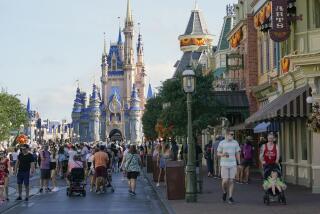Data suggest the super-rich are opening wallets wider at theme parks
- Share via
Reporting from Orlando, Fla. — The economy could be teetering on the edge of a double-dip recession, and theme parks are still tossing discounts at reluctant travelers. But there are encouraging signs from at least one small segment of consumers: the super-rich.
New data compiled by American Express Business Insights, a unit of credit card giant American Express Co., suggests that what the company calls “ultra-affluent” consumers are beginning to open their wallets wider when inside theme parks — much more so than everyone else.
Perhaps sensing a similar shift, the parks themselves are moving ahead with new offerings aimed at the upper crust. After several years of planning and site preparation, last month Walt Disney World Resort began presales of homes inside its exclusive Golden Oak residential development, where multistory mansions will be priced as high as $8 million each. SeaWorld Parks & Entertainment, meanwhile, is expanding Discovery Cove, its limited-admission boutique park where swim-with-dolphin packages start at $199 a person.
Abe Pizam, dean of the University of Central Florida’s Rosen College of Hospitality Management, said one explanation could be that rich travelers are beginning to feel more comfortable displaying their wealth now that the worst has passed of a brutal global recession in which extravagant spending would have been considered shameful.
“I think these people didn’t spend a lot before not because they couldn’t afford to, but because it was not socially acceptable,” Pizam said. “Now it is not so shameful as it was.”
According to American Express, spending at theme parks by ultra-affluent cardholders jumped 32% during the first quarter of the year compared with a year earlier. Spending at theme parks by the remainder of the company’s cardholders was up just 1%.
The data was culled from the spending records of American Express cardholders. The company classifies ultra-affluent consumers as those who charge at least $7,000 a month on their cards, or a minimum of $84,000 in credit-card charges each year.
“You want to take advantage of this niche market if you can,” Pizam said. “But they’re not going to make up for the losses of the hundreds of thousands of others who still can’t afford it. Let’s be honest, the parks are not built for the ultra-rich. They are built for the masses.”
Still, any positive trends are welcome after two years of grim economic news. And the parks are positioning themselves to capitalize on a rich-traveler rebound.
SeaWorld, for instance, is moving forward with plans to expand its 10-year-old Discovery Cove. Built around intimate experiences such as swimming with dolphins and hand-feeding parrots, Discovery Cove features limited admission — capped at 1,050 guests a day — and average ticket prices that are nearly three times as expensive as those of typical theme parks.
Company executives revealed plans for the expansion earlier this year while helping host an annual trade show for travel agents and other travel professionals. They said the additions would include a new tropical reef for swimming with sea life such as lionfish and sharks, and an island nature trail. But they have declined to provide further details since then; a more formal announcement is expected this fall.
Although SeaWorld does not track guests’ income levels, a spokesman said the park is also seeing strong demand for high-end experiences such as shark encounters and beluga-whale interactions at SeaWorld and its “trainer for a day” program at Discovery Cove, which can cost more than $500 a person.
”
Disney is aiming for an even higher tax bracket with Golden Oak, where prospective buyers will have to plunk down $25,000 just to get their names on a priority reservation list.
In the works for more than two years, the exclusive development has been master-planned by the company’s Imagineering unit. It will ultimately have about 450 homes spread across 980 acres in the northeast corner of the vast resort. Disney, which announced last month that it would begin sales, says Golden Oak homes — to be built in a handful of predetermined styles such as Spanish Revival, Dutch Colonial and Venetian — will be priced between $1.5 million and $8 million apiece.
In marketing materials, Disney touts a “privilege package” for Golden Oak residents, who will have concierge service available to arrange everything from theme-park tickets and groceries to a holiday home-decoration service. Residents will also have access to the amenities in a 445-room Four Seasons hotel to be built as part of the development.
Matt Kelly, a vice president with the Disney division overseeing Golden Oak, said the company’s research has revealed a rebound in the luxury real-estate market, much as American Express has found in broader consumer spending.
“We saw enough positive signs that we thought this made sense to go ahead and announce the project and move forward,” Kelly said. He added that Disney has received inquiries from prospective buyers in states such as Texas, Wyoming and New York and from overseas markets including Britain and in South America.
Some people have already given Disney the $25,000 deposits.
“We’re very pleased with the way it’s filling up,” Kelly said.
Garcia writes for the Orlando Sentinel/McClatchy.
More to Read
Inside the business of entertainment
The Wide Shot brings you news, analysis and insights on everything from streaming wars to production — and what it all means for the future.
You may occasionally receive promotional content from the Los Angeles Times.










